2. 中国科学院西北生态环境资源研究院寒区旱区陆面过程 与气候变化重点实验室, 兰州 730000
积雪是地球上一种典型的下垫面, 其分布主要受温度的影响, 从低海拔地区向高海拔地区逐渐增多, 沿赤道向两极逐渐增多, 中国三大稳定积雪区分别位于新疆、东北和青藏高原 (李栋梁和王春学, 2011; 沈永平等, 2013; 黄芳芳等, 2016; Qian et al, 2003; 许立言等, 2012)。积雪还是气候系统的响应器, 同时作为一种重要的陆面强迫因子, 对气候产生重要影响 (唐红玉等, 2014; 卢楚翰等, 2014; 王澄海等, 2000; 周利敏等, 2016), 特别是青藏高原积雪被视为中国短期气候预测的重要因子 (李栋梁和王春学, 2011), 青藏高原积雪对亚洲季风系统的形成以及我国长江中下游地区的降水预测有着至关重要的作用。积雪陆面过程的研究对提高我国短期气候的预测水平 (刘晓东等, 1991; 李如琦等, 2015; 张少波等, 2013) 有重要的参考价值。气候变暖加速了积雪的融化, 使地表吸收了更多的太阳辐射, 从而对气候存在正的辐射强迫效应 (肖林和车涛, 2015)。积雪覆盖会减少地表吸收的短波辐射, 从而降低地表温度, 改变感、潜热能量输送。积雪消融的过程中, 净辐射是雪面最主要的能量来源, 其次是感热。雪面吸收的能量主要用来融化和蒸发积雪 (陆恒等, 2015); 积雪的消融可使冬、春季地表反照率的“V”型向左倾 (张强等, 2011), 进一步影响辐射、能量平衡和近地层气象要素的日变化特征。雪面上辐射和能量平衡特征多导致其上温度层结多为近中性和稳定状态 (Hicks and Martin, 1972; Smeets et al, 1992; 卢盼盼和吴晓庆, 2009), 随着新雪的沉积, 夜晚大气的稳定性呈增强趋势, 白天正午附近大气呈中性到不稳定的状况略有增加 (卢盼盼和吴晓庆, 2009), 但当冰雪面近地层冷空气同北极高空较强的暖湿气流相互作用时, 会形成强风切变和逆温、逆湿过程, 有时100 m高度内的风切变达10 m·s-1, 逆温达8 ℃(卞林根等, 2006)。近地层气象要素特征的改变将影响感、潜热通量的分配 (李娟等, 2009), 感、潜热通量值随着大气稳定度的增强而减小, 反之则增大。
积雪通过表面不同的反照率和不同的湍流通量形成了陆面与大气间独特的能量交换, 影响近地层气象要素特征, 反过来其对湍流和能量交换又有重要影响, 但目前对于积雪下垫面近地层气象要素特征, 特别是青藏高原高寒草甸地区雪面温度层结的研究相对较少, 因此本文将利用黄河源区玛曲站的观测资料分析有雪和无雪时梯度塔不同高度气象要素特征, 揭示积雪对大气温度层结特征的影响, 有助于加强对积雪陆面过程的认识。
2 研究区域及资料 2.1 观测站点描述中国科学院玛曲黄河源区气候与环境综合观测研究站位于甘肃省甘南藏族自治州西南部的玛曲县河曲马场草场内 (102°08′E, 33°53′N), 海拔3423 m。地处青藏高原东北边缘地带, 甘、青、川三省交界处, 被称为黄河第一弯曲部, 其独特的地理位置使得该地气候寒冷, 冬季地表主要以高寒草甸类和高寒草原类草地为主, 在稀疏植被覆盖下大面积分布着季节性冻土。
2.2 资料介绍选用玛曲站2011年12月20日至2012年3月6日的观测资料和玛曲气象局台站的降水资料进行分析, 观测场资料包括向上、向下太阳短波辐射 (1. 5 m)、空气温度 (2.35 m, 4.2 m, 7. 17 m, 10. 13 m和18. 15 m)、风向风速 (2.35 m, 4.2 m, 7. 17 m, 10. 13 m和18. 15 m)。采用的实验仪器及架设高度的相关参数如表 1所示, 所有数据均为自动采集。相关数据的采集频次分别为:太阳短波辐射数据每30 min采集一次; 空气温度和风向风速数据每10 min采集一次。实验正式开始前, 不同高度仪器被放在同一高度进行了对比实验, 观测结果显示各个仪器均具有较好的一致性, 仪器满足观测的精度要求, 其中CNR1净辐射传感器的精度是±25 W·m-2, HMP45C温湿度传感器的精度在20 ℃时是±0. 2 ℃, Wind Sonic超声波风速风向仪的精度是±2%。
3 积雪对温度的影响 3.1 降雪及积雪过程观测期内, 玛曲地区没有连续长时间的积雪, 一次积雪过程维持时间一般只有2~5天。积雪具有较大的地表反照率, 观测期内有雪时 (图 1d~f) 地表反照率≥0. 4;无雪时 (图 1a~c) 地表反照率较小, 小于0. 4。由于观测的积雪厚度存在一定的缺陷, 因而利用地表反照率变化特征确定了3次积雪过程, 分别为1月3-6日, 2月17-18日, 2月29至3月4日, 其中1月3日, 2月17日, 2月29日正午反照率较前几日增大显著, 正午反照率≥0. 6, 随后反照率逐渐降低。玛曲气象局台站降水资料显示, 第一次积雪过程只有1月2日夜晚有降水, 降水量为3.3 mm。第二次过程的降水发生在2月17日, 降水量为4.3 mm, 其中2月16日20:00到2月17日08:00的降水量为1. 0 mm, 2月17日08:00-20:00的降水量为3.3 mm。第三次过程的降水发生在2月29日, 日累积降水量为3.2 mm, 白天08:00-20:00降水量达到1. 0 mm。3月1日、3月2日、3月3日夜晚降水量分别为2.9 mm、0. 2 mm和0. 8 mm, 白天几乎没有降水。这三次降水过程的气温较低, 都小于0 ℃, 同时降水发生后对应的反照率都较大, 因此判定这三次降水均为降雪。
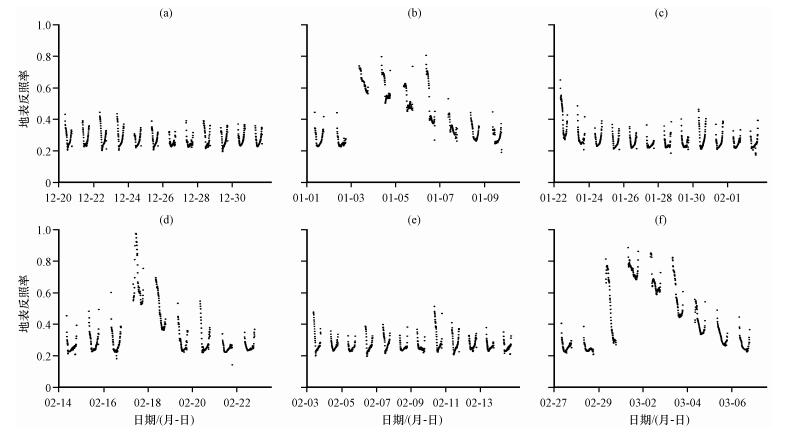
|
图 1 2011年12月20日至2012年3月6日玛曲地表无雪 (a、c、e) 与有雪 (b、d、f) 覆盖时的反照率 (a) 2011年12月20-31日, (b) 2012年1月1-9日, (c) 2012年1月22日至2月2日, (d) 2012年2月14-22日, (e) 2012年2月3-14日, (f) 2012年2月27日至3月6日 Figure 1 Surface albedo during no snow (a、c、e) and snow (b、d、f) in Maqu from 20 December 2011 to 6 March 2012 (a) from 20 to 31 December 2011, (b) from 1 to 9 January 2012, (c) from 22 January to 2 February 2012, (d) from 14 to 22 February 2012, (e) from 3 to 14 February 2012, (f) from 27 February to 6 March 2012 |
通过三次积雪过程及前后两天近地层气温分布 (图 2) 可以看出, 观测期内1月平均气温只有-10. 3 ℃, 2月为-5. 5 ℃, 3月达到了-2.3 ℃。第一次积雪过程发生在气温较低的隆冬时节, 降雪过程只发生在1月2日夜晚。发生降雪前的1月1日日最高气温为4.3 ℃, 最低为-18. 7 ℃。降雪后的1月3日日最高气温为-7. 3 ℃, 最低为-28. 5 ℃。只需1天便可以达到最大降幅10 ℃。如此大幅度的降温再加上1月份大气温度本来就较低, 导致积雪不容易融化, 在地表维持了4天, 从而造成气温回升比其它两个过程慢, 日最高和最低气温平均回升速率分别为1. 5 ℃·d-1和3.5 ℃·d-1左右。第二次积雪过程发生在2月17-18日, 降雪过程主要在17日, 17日日最高气温在16日5. 4 ℃的基础上下降至-2.7 ℃, 但最低气温变化不大, 仍为-12 ℃左右。18日最高气温较17日上升2.33 ℃, 18日后气温逐渐回升, 从18-21日最高和最低气温均以日均3.3 ℃·d-1的速率回升。第三次过程降雪发生在2月29日全天及3月1、2、3日夜晚, 3月气温较高, 积雪融化较快, 3月5日积雪已全部消融, 气温恢复到了降雪前的状态。第一次过程降雪量较小, 降雪结束后气温恢复降雪前状态所用的时间较长。第三次降雪量最大, 但气温很快便能恢复, 这是因为3月平均气温较高, 降水量对气温的影响小于季节的影响。
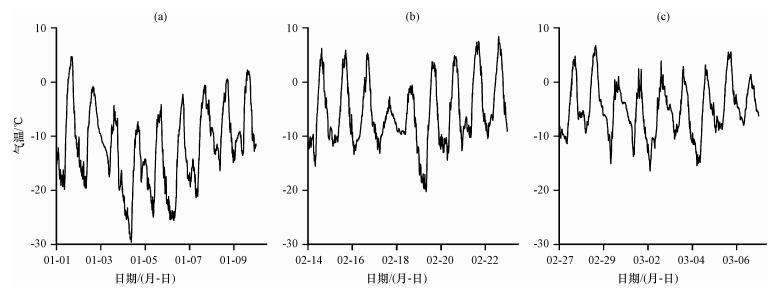
|
图 2 2011年12月20日至2012年3月6日玛曲三次 (a~c) 降雪前后气温分布 (a) 2012年1月1-9日, (b) 2012年2月14-22日, (c) 2012年2月27日至3月6日 Figure 2 Air temperature variation before and after the three-snow process in Maqu from 20 December 2011 to 6 March 2012 (a) from 1 to 9 January 2012, (b) from 14 to 22 February 2012 (c) from 27 February to 6 March 2012 |
图 3为无雪期 (图 3a、c、e) 和有雪期 (图 3b、d、f) 各层温度梯度时间序列分布, 其中有64个晴天无积雪样本天, 19个晴天积雪样本天。白天地表吸收太阳辐射升温, 获得的能量以感热的形式向上输送加热大气, 气温随高度降低, 温度梯度为负; 越靠近地表的气温越容易受地表温度的影响, 7. 17 m以下平均为-0. 3 ℃·m-1, 以上平均为-0. 1 ℃·m-1, 相差0. 2 ℃·m-1。夜晚, 地表向大气释放热量, 相对于气温, 地表温度降低较快, 形成正的温度梯度, 7. 17 m以下平均为0. 6 ℃·m-1, 以上平均为0. 2 ℃·m-1, 相差0. 4 ℃·m-1。白天地表对大气加热, 使大气混合较为均匀, 温度梯度绝对值比夜晚小, 白天7. 17 m以下和以上的温度梯度绝对值比夜晚分别偏小0. 3 ℃·m-1和0. 1 ℃·m-1。
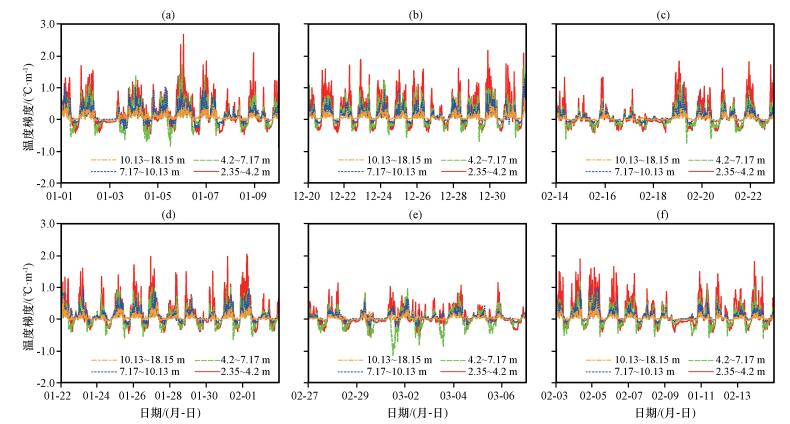
|
图 3 2011年12月20日至2012年3月6日玛曲无雪 (a、c、e) 与有雪 (b、d、f) 时温度梯度 (单位: ℃·m-1) (a) 2011年12月20-31日, (b) 2012年1月1-9日, (c) 2012年1月22日至2月2日, (d) 2012年2月14-22日, (e) 2012年2月3-14日, (f) 2012年2月27日至3月6日 Figure 3 Temperature gradient during no snow (a、c、e) and snow (b、d、f) in Maqu from 20 December 2011 to 6 March 2012. Unit: ℃·m-1 (a) from 20 to 31 December 2011, (b) from 1 to 9 January 2012, (c) from 22 January to 2 February 2012, (d) from 14 to 22 February 2012, (e) from 3 to 14 February 2012, (f) from 27 February to 6 March 2012 |
通过有、无雪时2.35~4.2 m、4.2~7. 17 m、7. 17~10. 13 m、10. 13~18. 15 m温度梯度24 h分布 (图 4) 可以看出, 积雪使夜晚20:00至次日08:00各层正温度梯度值比无雪时小, 平均偏小0. 2 ℃·m-1, 其中从下往上的各层分别偏小0. 4、0. 2、0. 15和0. 05 ℃·m-1。积雪减弱了地表对大气的加热作用, 除白天4.2~7. 17 m负温度梯度绝对值增大, 积雪使11:00-16:00的2.35~4.2 m、7. 17~10. 13 m、10. 13~18. 15 m平均负温度梯度绝对值比无雪时偏小0. 15 ℃·m-1左右, 各层分别偏小0. 3、0. 1和0. 05 ℃·m-1, 甚至出现正值。尽管三次过程降水量存在差异, 但除4.2~7. 17 m外的三层平均温度梯度绝对值在三次降雪后晴天个例 (1月4日、2月18日、3月2日) 比降雪前晴天个例 (1月1日、2月15日、2月28日) 都偏小0. 1 ℃·m-1左右, 降水量对降雪前后晴天温度梯度影响不明显。
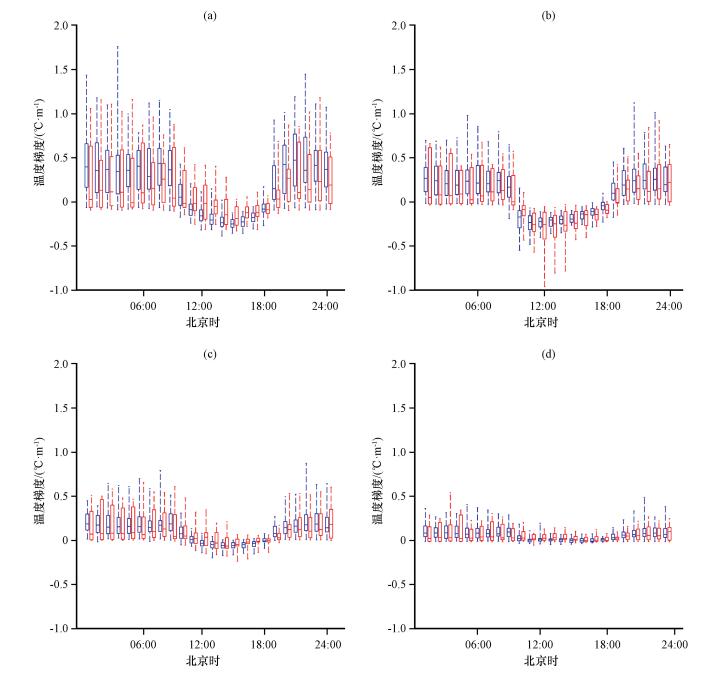
|
图 4 2011年12月20日2012年3月6日玛曲2.35~4. 2 m (a)、4. 2~7. 17 m (b)、7. 17~10. 13 m (c)、10. 13~18. 15 m (d) 有 (红色)、无雪 (蓝色) 时温度梯度24 h分布 Figure 4 Temperature gradient distribution of 24 hours at 2.35~4. 2 m (a) and 4. 2~7. 17 m (b) and 7. 17~10. 13 m (c) and 10. 13~18. 15 m between snow (red) and no snow (blue) from 20 December 2011 to 6 March 2012 |
图 5是三次积雪过程温度廓线分布, 三次积雪过程降雪前晴天 (1月1日、2月15日、2月28日)10:00左右, 温度开始随高度减小。有积雪晴天 (1月4日、2月18日、3月2日)11:00左右, 温度随高度减小的趋势才表现出来, 比无雪时滞后1 h。降雪前17:00温度开始随高度升高, 有积雪时16:00这种趋势便表现出来。因此, 当地表有积雪覆盖时, 早上温度随高度减小的变化趋势比无雪时落后1 h出现, 傍晚温度随高度升高的变化趋势比无雪时提前1 h。
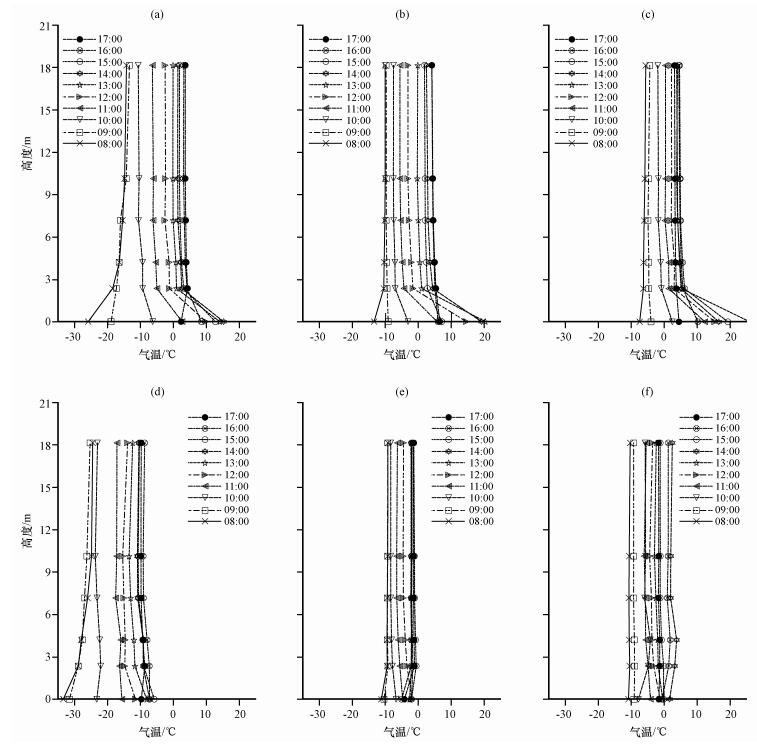
|
图 5 2011年12月20日2012年3月6日玛曲三次积雪过程前 (a~c) 后 (d~f) 气温廓线 (a) 2012-01-01, (b) 2012-02-15, (c) 2012-02-28, (d) 2012-01-04, (e) 2012-02-18, (f) 2012-03-02 Figure 5 Temperature and wind profile before (a~c) and after (d~f) the three snow process in Maqu from 20 December 2011 to 6 March 2012 |
三次积雪过程中, 有积雪的白天气温分布范围 (三次过程分别为:-26~-10 ℃、-9~-2 ℃、-10~2 ℃) 比无雪时 (-16~5 ℃、-10~6 ℃、-8~6 ℃) 分别偏小5 ℃、9 ℃、2 ℃。其中第二次积雪过程偏小幅度最大, 晴天气温分布范围最窄。这可能是因为第二次积雪过程中风速较大, 2月18日14:00以后风速值可达10 m·s-1(图 6), 气象要素混合均匀, 各层温度趋于一致。在背景风速较大的情况下, 观测的近地层温度随时间无明显变化。
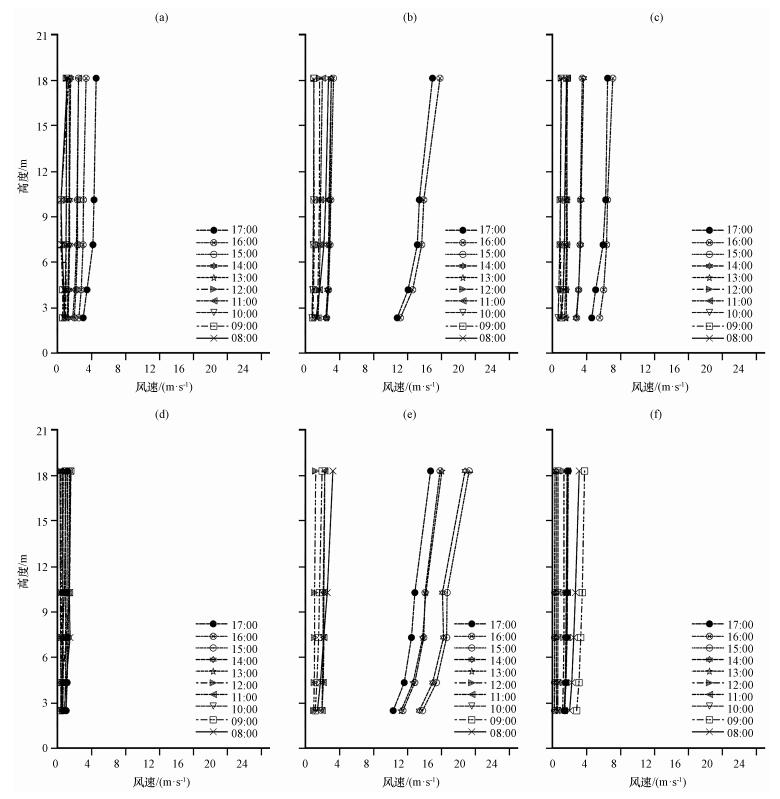
|
图 6 2011年12月20日-2012年3月6日玛曲三次积雪过程前 (a~c) 后 (d~f) 风速廓线 (a) 2012-01-01, (b) 2012-02-15, (c) 2012-02-28, (d) 2012-01-04, (e) 2012-02-18, (f) 2012-03-02 Figure 6 Wind profile before (a~c) and after (d~f) the three snow process in Maqu from 20 December 2011 to 6 March 2012 |
除风速较大的第二次积雪过程外, 有无雪时晴天白天11:00-16:00, 4.2 m都有一个向右的凸起, 4.2 m偏暖, 有雪时4.2 m偏暖加强, 其中第三次积雪过程比第一次偏暖更强, 这与降水量有较好的对应关系。第二次积雪过程4.2 m没有偏暖表现, 可能是因为风速较大所致。
3.4.2 白天4.2 m偏暖可能原因分析观测期内64个晴天无积雪样本天 (图 7a) 和9个阴天无积雪样本天 (图 7b) 表明; 11:00-16:00 4.2~7. 17 m在晴天的温度梯度绝对值比2.35~4.2 m偏大0. 1~0. 25 ℃·m-1, 在阴天却比2.35~4.2 m偏小0. 1 ℃·m-1, 不存在4.2~7. 17 m温度梯度异常, 4.2 m偏暖的现象在阴天不存在。并且在夜晚也不存在, 同时在实验开始前对观测仪器进行了对比, 不存在仪器误差, 所以白天4.2 m偏暖是确实存在的。晴天白天地表有无积雪覆盖时4.2 m风向无规律分布 (图 7c), 4.2 m偏暖并不是由来自某个固定方向的暖平流造成。4.2 m偏暖可能是因为观测场内比场外植被密集, 当地表无积雪时, 晴天白天观测场内地表温度相对于观测场外低, 可形成从四周吹向观测场的暖平流; 有积雪时, 观测场内积雪比观测场外积雪融化快, 需吸收更多的热量, 导致观测场内外温差比无雪时大, 温度更低, 增强了有雪时4.2 m偏暖强度, 第三次过程较多的降雪的融化导致4.2 m偏暖更强。所以当应用观测资料分析及驱动、验证模式时, 有梯度资料时最好先挑选合适高度的资料对各层进行比较, 避免这种平流带来的不正确的信息。
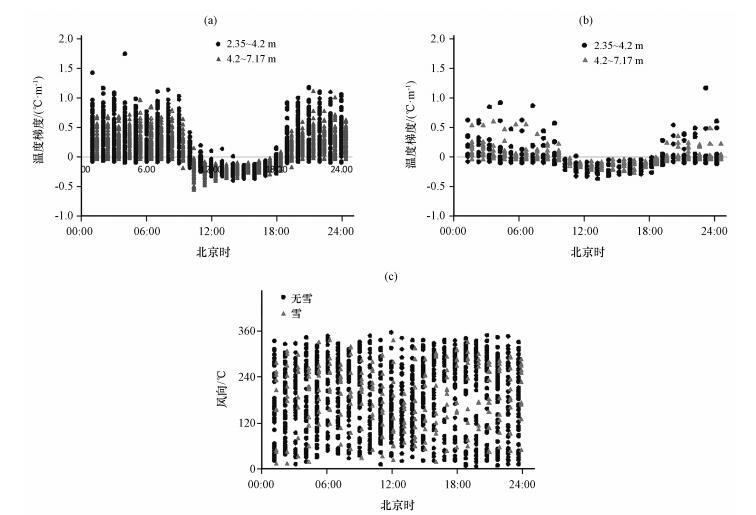
|
图 7 2011年12月20日至2012年3月6日玛曲4. 2~7. 17 m和2.35~4. 2 m在晴天 (a)、阴天 (b) 温度梯度24 h分布及4. 2 m风向 (c) 在有、无雪时24 h分布 Figure 7 Temperature gradient of sunny days (a) and cloudy days (b) at 4. 2~7. 17 m and 2.35~4. 2 m for 24 hours and Wind's 24 hours distribution (c) during snow and no snow from 20 December 2011 to 6 March 2012 |
(1) 降雪前受冷空气过境的影响气温下降较快, 一天便可达到近期最大降幅10 ℃, 三次积雪过程相比, 雪后, 季节气温越低, 积雪越不容易融化, 在地表维持时间越长, 气温回升越慢。
(2) 在整个观测期内, 不管地表有无积雪覆盖, 越靠近地表的气温越容易受地表温度的影响, 7. 17 m以下平均为-0. 3 ℃·m-1, 以上平均为-0. 1 ℃·m-1。夜晚, 7. 17 m以下平均为0. 6 ℃·m-1, 以上平均为0. 2 ℃·m-1, 白天地表对大气加热, 使大气混合较为均匀, 温度梯度绝对值比夜晚小。
(3) 积雪减小了夜晚各层正温度梯度值, 各层平均减小了0. 2 ℃·m-1, 同时减小了白天11:00-16:00 2.35~4.2 m、7. 17~10. 13 m、10. 13~18. 15 m平均负温度梯度绝对值。
(4) 三次积雪过程中, 地表有积雪覆盖时早上温度随高度减小的趋势比无雪覆盖时落后1 h出现, 傍晚温度随高度增大的趋势提前1 h出现。有积雪的白天气温分布范围比无雪时小, 其中第二次积雪过程偏小幅度最大, 晴天气温分布范围最窄, 这可能是因为第二次积雪过程中风速较大导致。
(5) 晴天白天4.2~7. 17 m温度梯度绝对值比2.35~4.2 m偏大, 出现这种异常主要是受4.2 m偏暖的影响, 这可能是由观测场内外下垫面植被覆盖不同而引起的温度平流所致; 当有积雪覆盖时偏大幅度明显增大; 当风速较大时, 将破坏这种平流作用。
| Grenfell T C, Warren S G, Mullen P C. 1994. Reflection of solar radiation by the Antarctic snow surface at ultraviolet, visible, and near-infrared wavelengths[J]. JGeophys Res: Atmospheres, 99(D9): 18669–18684. DOI:10.1029/94JD01484 | |
| Hicks BB, Martin H C. 1972. Atmospheric turbulent fluxes over snow[J]. Bound-Layer Meteor, 2(4): 496–502. DOI:10.1007/BF00821551 | |
| Smeets C, Duynkerke P G, Vugts H F. 1999. Observed wind profiles and turbulence fluxes over an ice surface with changing surface roughness[J]. Bound-Layer Meteor, 92(1): 99–121. DOI:10.1023/A:1001899015849 | |
| Qian Y F, Zheng Y Q, Zhang Y, et al. 2003. Responses of China's summer monsoon climate to snow anomaly over the Tibetan Plateau[J]. Int J Climatol, 23(6): 593–613. DOI:10.1002/(ISSN)1097-0088 | |
| 卞林根, 陆龙骅, 张占海, 等. 2006. 北冰洋浮冰站大气边界层结构的观测研究[J]. 极地研究, 18(2): 87–97. | |
| Bian Lingen, Lu Longhua, Zhang Zhanhai, et al. 2006. Analysis of structure of atmospheric layer in ice camp over Arctic Ocean[J]. Polar Research, 18(2): 87–97. | |
| 郭建平, 刘欢, 安林昌, 等. 2016. 2001-2012年青藏高原积雪覆盖率变化及地形影响[J]. 高原气象, 35(1): 24–33. | |
| Guo Jianping, Liu Huan, An Linchang, et al. 2016. Study on variation of snow cover and its orographic impact over Qinghai-Xizang plateau during 2001-2012[J]. Plateau Meteor, 35(1): 1236–1245. DOI:10.7522/j.issn.1000-0534.2014.00140 | |
| 黄芳芳, 马伟强, 李茂善, 等. 2016. 藏北高原地表温度对气候变化响应的初步分析[J]. 高原气象, 35(1): 55–63. | |
| Huang Fangfang, Ma Weiqiang, Li Maoshan, et al. 2016. Analysis on responses of land surface temperature on the Northern Tibetan Plateau to climate change[J]. Plateau Meteor, 35(1): 55–63. DOI:10.7522/j.issn.1000-0534.2015.00075 | |
| 李栋梁, 王春学. 2011. 积雪分布及其对中国气候影响的研究进展[J]. 大气科学学报, 34(5): 628–636. | |
| Li Dongliang, Wang Chunxue. 2011. Research progress of snow cover and its influence on China climate[J]. Trans Atmos Sci, 34(5): 627–636. | |
| 卢楚翰, 管兆勇, 李震坤, 等. 2014. 春季欧亚大陆积雪对春夏季南北半球大气质量交换的可能影响[J]. 大气科学, 38(6): 1186–1197. | |
| Lu Chuhan, Guan Zhaoyong, Li Zhenkun, et al. 2014. Effects on inter-hemispheric air mass exchange between the Sourthern and Northern Hemisphere by Eurasian spring snow[J]. Chinese J Atmos Sci, 38(6): 1185–1197. | |
| 刘晓东, 惠小英, 陈葆德, 等. 1991. 夏季青藏高原与热带西太平洋下垫面热源异常对中国短期气候的影响[J]. 高原气象, 10(3): 305–306. | |
| Liu Xiaodong, Hui Xiaoying, Chen Baode, et al. 1991. Underlying surface over tibetan plateau and western tropical pacific on short-term climate in china[J]. Plateau Meteor, 10(3): 305–306. | |
| 李如琦, 唐冶, 肉孜·阿基. 2015. 2010年新疆北部暴雪异常的环流和水汽特征分析[J]. 高原气象, 34(1): 155–162. DOI:10.7522/j.issn.1000-0534.2013.00163 | |
| Li Ruqi, Tang Ye, RouZi Aji. 2015. Atmospheric circulation and water vapor characteristics of snowstorm anomalies in Northern Xinjiang in 2010[J]. Plateau Meteor, 34(1): 155–162. DOI:10.7522/j.issn.1000-0534.2013.00163 | |
| 陆恒, 魏文寿, 刘明哲, 等. 2015. 融雪期天山西部森林积雪表面能量平衡特征[J]. 山地学报, 33(2): 173–182. | |
| Lu Heng, Wei Wenshou, Liu Mingzhe, et al. 2015. The characteristic of energy budget on snow surface beneath picea schrenkiana forest in the west Tianshan Mountains of China during snowmelt period[J]. J Mountain Sci, 33(2): 173–182. | |
| 卢盼盼, 吴晓庆. 2009. 雪面上光学湍流的测量与估算[J]. 强激光与粒子束, 21(5): 667–671. | |
| Lu Panpan, Wu Xiaoqing. 2009. Estimation and measurements of optical turbulence over snow[J]. High Power Laser and Particle Beams, 21(5): 667–671. | |
| 李娟, 杨智, 袁家峰, 等. 2009. 川滇地区湍流通量与大气稳定度的关系[J]. 云南大学学报 (自然科学版), 31(S2): 451–454. | |
| LiJuan, YangZhi, Yuan Jiafeng, et al. 2009. The relationship between turbulent flux and atmospheric stability at sichuan and yunnan[J]. Journal of Yunnan University (Natural Science), 31(S2): 451–454. | |
| 李英, 李跃清, 赵兴炳. 2009. 青藏高原东坡理塘地区近地层湍流通量与微气象特征研究[J]. 气象学报, 67(3): 417–425. DOI:10.11676/qxxb2009.041 | |
| Li Ying, Li Yueqing, Zhao Xingbing. 2009. Analyses of turbulent fluxes and micrometeorological characteristics in the surface layer at Litang of the eastern Tibetan Plateau[J]. Acta Meteor Sinica, 67(3): 417–425. | |
| 李祥余, 何清, 艾力·买买提明, 等. 2008. 塔中春季晴天近地层风速、温度和湿度廓线特征分析[J]. 干旱区地理, 31(3): 389–396. | |
| Li Xianyu, He Qing, ALi Mamtimin, et al. 2008. Characteristic analysis of wind velocity, temperature and humidity profile in the spring in Tazhong[J]. Arid Land Geography, 31(3): 389–396. | |
| 乔娟. 2009. 西北干旱区大气边界层时空变化特征及形成机理研究[D]. 北京: 中国气象科学研究院, 1-76. | |
| Qiao Juan.2009.The temporal and spatial characteristics of atmospheric boundary layer and its formation mechanism over arid region of northwest china[D].Beijing: Chinese academy of meteorological science, 1-76. | |
| 沈永平, 苏宏超, 王国亚, 等. 2013. 新疆冰川、积雪对气候变化的响应 (Ⅰ):水文效应[J]. 冰川冻土, 35(3): 513–527. | |
| Shen Yongping, Su Hongchao, Wang Guoya, et al. 2013. The responses of glaciers and snow cover to climate change in Xinjiang (Ⅰ): Hydrological effect[J]. Journal of Glaciology and Geocryology, 35(3): 513–527. | |
| 沈永平, 苏宏超, 王国亚, 等. 2013. 新疆冰川、积雪对气候变化的响应 (Ⅱ):水文效应[J]. 冰川冻土, 35(3): 1355–1370. | |
| Shen Yongping, Su Hongchao, Wang Guoya, et al. 2013. The responses of glaciers and snow cover to climate change in Xinjiang (Ⅱ): Hazards effects[J]. Journal of Glaciology and Geocryology, 35(6): 1355–1370. | |
| 唐红玉, 李锡福, 李栋梁. 2014. 青藏高原春季积雪多、少年中低层环流对比分析[J]. 高原气象, 33(5): 1190–1196. DOI:10.7522/j.issn.1000-0534.2013.00125 | |
| Tang Hongyu, Li Xifu, Li Dongliang. 2014. Contrast of circulation pattern related to more and less spring snow cover over Qinghai-Xizang Plateau[J]. Plateau Meteor, 31(3): 706–714. DOI:10.7522/j.issn.1000-0534.2013.00125 | |
| 王澄海, 董安祥, 王式功, 等. 2000. 青藏高原积雪与西北春季降水的相关特征[J]. 冰川冻土, 22(4): 340–346. | |
| Wang Chenhai, Dong Anxiang, Wang Shigong, et al. 2000. The correlation between precipitation in Northwest China during spring and snow depth in the Tibetan Plateau[J]. Journal of Glaciology and Geocryology, 22(4): 340–346. | |
| 王少影, 张宇, 吕世华, 等. 2012. 玛曲高寒草甸地表辐射与能量收支的季节变化[J]. 高原气象, 31(3): 605–614. | |
| Wang Shaoying, Zhang Yu, Lü Shihua, et al. 2012. Seasonal variation characteristics of radiation and enery in alpine meadow ecosystem in maqu grassland[J]. Plateau Meteor, 31(3): 605–614. | |
| 许立言, 武炳义. 2012. 欧亚大陆积雪与2010年中国春末夏初降水的关系[J]. 高原气象, 31(3): 706–714. | |
| Xu Liyan, Wu Bingyi. 2012. Relationship between Eurasian snow cover and late-spring and early-summer rainfall in China in 2010[J]. Plateau Meteor, 31(3): 706–714. | |
| 肖林, 车涛. 2015. 青藏高原积雪对气候反馈的初步研究[J]. 遥感技术与应用, 30(6): 1066–1075. | |
| Xiao Lin, Che Tao. 2015. Preliminary study on snow feedback to the climate system in the Tibetan Plateau[J]. Remote Sensing Technology and Application, 30(6): 1066–1075. | |
| 周利敏, 陈海山, 彭丽霞, 等. 2016. 青藏高原冬春雪深年代际变化与南亚高压可能联系[J]. 高原气象, 5(1): 13–23. | |
| Zhou Limin, Chen Haishan, Peng Lixia, et al. 2016. Possible connection between interdecadal variations of snow depth in winter and spring over Qinghai-Xizang Plateau and South Asia high in summer[J]. Plateau Meteor, 35(1): 13–23. | |
| 张少波, 陈玉春, 吕世华, 等. 2013. 青藏高原植被变化对中国东部夏季降水影响的模拟研究[J]. 高原气象, 32(5): 1236–1245. | |
| Zhang Shaobo, Gheng Yuchun, Lü Shihua, et al. 2013. Numerical Simulation of Impact of Vegetation in Qinghai-Xizang Plateau on Summertime Precipitation in Eastern China[J]. Plateau Meteor, 32(5): 1236–1245. DOI:10.7522/j.issn.1000-0534.2012.00119 | |
| 张强, 孙昭萱, 王胜. 2011. 黄土高原定西地区陆面物理量变化规律研究[J]. 地球物理学报, 54(7): 1727–1737. | |
| Zhang Qiang, Sun Zhaoxuan, Wang Sheng. 2011. Analysis of variation regularity of land-surface physical quantities over Dingxi Region of the Loess Plateau[J]. Chinese J Geophys, 54(7): 1727–1737. |
2. Key Laboratory of Land Surface Processes and Climate Change in Cold and Arid Regions, Northwest Institute of Eco-Environment, Chinese Academy of Science, Lanzhou 730000, China
 2017, Vol. 36
2017, Vol. 36
